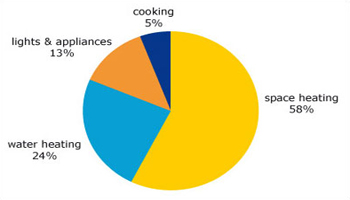7 Waste heat
Look at the typical use of energy in a home:

As you can see, over 82% of our energy use is for heating the space we live in or heating the water we use.
We also know that our thermal power stations reject more in heat energy than they deliver in electrical energy. Using section 4 of the Scottish Energy Study [Tip: hold Ctrl and click a link to open it in a new tab. (Hide tip)] (2006) as our reference, it appears that waste heat from our theremal stations is a little greater than what we need to heat our homes and services sector.
In practice it is, of course, not this simple. Our power stations tend not to have sufficient local opportunity for heat use (e.g. Torness is a long way from housing), and the cost of installing the necessary infrastructure is high. In addition, the waste heat would need to be extracted at a higher temperature to be useful, which marginally reduces the efficiency of electricity production.
There is, of course, public perception to consider. Perhaps public opinion would not accept domestic heating from a nuclear power station's heat. That would not stop the heat being used for other purposes, however.
This does raise the question about future power stations and whether we could be planning them to make effective use of the waste heat.
Combined heat and power (CHP) case study
We have identified that CHP can make heat available and provide electricity at much higher efficiencies. We'll now look at a case study of a small-scale CHP scheme which reveals other potential benefits, particularly if the scheme is designed to provide community benefits.
Activity 12
Please go to the Green Building Press website, and consider what community benefits this scheme in Aberdeen has provided.
Make notes on what you have read.
